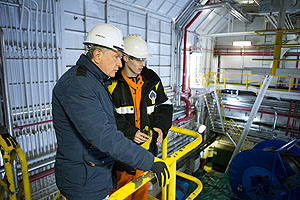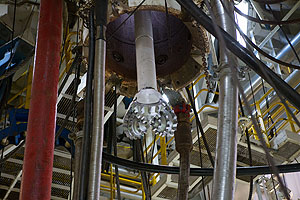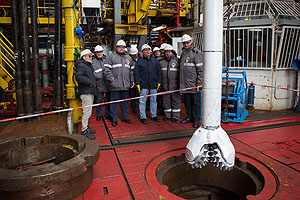Rosneft commences drilling in the Sea of Okhotsk
-350x1000.jpg)
The signal to begin drilling was given by the Rosneft Chairman of the Management Board Igor Sechin during the work at the rig Nanhai-9.
"Implementation of the offshore projects in upstream is one of the Company’s most important strategic goals, a contribution to the whole oil and gas industry. Rosneft is the country’s only company that continues the work on new projects offshore in accordance with its license obligations despite the complicated external environment. We are pleased to commence the key stage of project within the scope of the long-term cooperation with our partner – Statoil – the drilling of exploration wells in the Sea of Okhotsk" - Igor Sechin said.
 Well Ulberikanskaya-1 will be drilled at the prospect of the same name in Lisiansky license area one year ahead of the license obligations. The distance from the port of Magadan to the well is about 420 km. The second well of Rosneft and Statoil project will be also drilled during the 2016 season within Magadan-1 section in the Sea of Okhotsk.
Well Ulberikanskaya-1 will be drilled at the prospect of the same name in Lisiansky license area one year ahead of the license obligations. The distance from the port of Magadan to the well is about 420 km. The second well of Rosneft and Statoil project will be also drilled during the 2016 season within Magadan-1 section in the Sea of Okhotsk.
Semi-submersible rig Nanhai-9 was delivered by China Oilfield Services Limited (COSL) which signed a contract for drilling with the joint venture of Rosneft and Statoil in September 2015. The rig was transported through the South China Sea, the East China Sea, the Sea of Japan and the Sea of Okhotsk; to reach the point of drilling, the rig traveled a long way of more than 4600 nautical miles. Nanhai-9 was specially modified for the drilling project in the Sea of Okhotsk: in particular, a comprehensive preparation of the rig was implemented to enable its operation at low ambient temperatures, wind protection was installed on the perimeter of the drilling site, a range of services were held to ensure environmentally safe operations. The Sea of Okhotsk lies south of the Arctic zone boundary, the sea depth in both drilling sites is less than 150 m.
|
Note for editors: Rosneft and Statoil ASA signed a Cooperation Agreement in 2012 to jointly explore areas of the Russian shelf and for Rosneft to join in the exploration of the Norwegian shelf. Under this agreement, the companies set up joint ventures, completed a series of exploration operations including 2D and 3D seismic and geotechnical surveys. Rosneft is committed to all of its offshore drilling obligations every year. The Company plans to keep the pace of the large-scale exploration program. In 2016, in addition to the drilling of two exploration and appraisal wells on the shelf of the Sea of Okhotsk, it is planned to acquire more than 26,000 km of 2D seismic; more than 2,000 km2 of 3D seismic; 67,000 km2 airborne geophysical surveys and a number of other jobs. To date, the exploration license commitments of the Company (total 55 areas with about 43 billion tons of total oil equivalent hydrocarbon resources) on the continental shelf are fully met well ahead of time and in excess of the required amount of work at a number of sites. Rosneft has performed an unprecedented scope of comprehensive geological and geophysical studies on the Russian shelf. More than 84,000 meters of 2D seismic were shot which exceeded the requirements of the license obligations more than twice. The Company also shot more than 18,000 km2 of 3D seismic which is almost 3 times higher than the license obligations. Airborne geophysical survey covered more than 636,000 km2 which is more than 3.5 times higher than the license obligations. An area of over 1 million km2 on the Russian shelf was explored. In 2014, Arctic exploration and appraisal well 1-Universitetskaya was successfully drilled in the Kara Sea which discovered Pobeda oil and gas field that proved oil and gas potential of the north Kara petroleum province; operations are in progress at the northern tip of Chayvo field in the Sea of Okhotsk. |
Rosneft Information Division
Tel.: + 7 (499) 517-88-97
June 2, 2016
 |
 |
 |
|
These materials contain statements about future events and expectations that are forward-looking in nature. Any statement in these materials that is not a statement of historical fact is a forward-looking statement that involves known and unknown risks, uncertainties and other factors which may cause actual results, performance or achievements expressed or implied by such forward-looking statements to differ. We assume no obligations to update the forward-looking statements contained herein to reflect actual results, changes in assumptions or changes in factors affecting these statements.